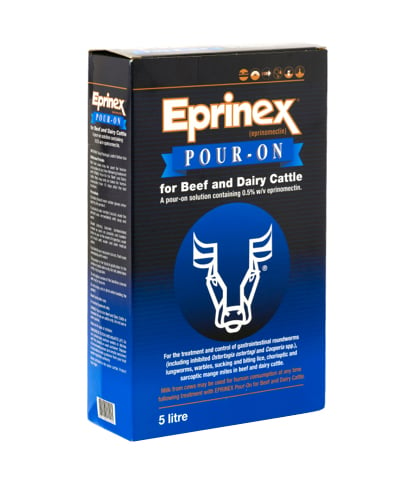EPRINEX - the first dairy and beef eprinomectin wormer with zero-milk withhold was launched over 21 years ago and is still the market-leading beef and dairy wormer in the UK1.
Available in: 1L, 2.5L and 5L

|
EPRINEX Dose Guide |
|||||
|
Bodyweight |
Number of treatments per pack |
||||
|
Dose |
1L |
2.5L |
5L |
||
|
200kg |
20mls |
50 |
125 |
250 |
|
|
300kg |
30mls |
33 |
83 |
166 |
|
|
400kg |
40mls |
25 |
62 |
125 |
|
|
500kg |
50mls |
20 |
50 |
100 |
|
|
600kg |
60mls |
16 |
41 |
83 |
|
|
700kg |
70mls |
14 |
35 |
71 |
|
|
800kg |
80mls |
12 |
31 |
62 |
|
Milk from cows may be used for human consumption at any time following treatment.

References
Yes EPRINEX Pour-On can be used in lactating cows and has a zero milk withdrawal so can be used at any stage of lactation.
EPRINEX Pour-On should be applied along the backline in a narrow strip extending from the withers to the tailhead. The dose should be measured using the measuring cup supplied or using an appropriate applicator gun. It is recommended to double check the calibration of these every time you apply the product.
Treatment around the time of calving will remove a cow’s gut worm burden and protect against re-infection during early lactation, optimising feed intake and energy balance during the transition period. The lactation-long benefits of removing gut worm at this time have been demonstrated, with cows shown to produce up to a litre more milk each day for the entire lactation1.
Reference:
1. Verschave et al. (2014) BMC Vet Res 10; 264-272
Whilst every effort should be made to ensure that cattle are treated under optimal conditions, there is clinical evidence to show that EPRINEX is rainfast. In cattle, rainfall before or after the application of the product has been shown to have no impact on its efficacy1. It has also been demonstrated that haircoat length has no impact on the product’s efficacy1.
Reference:
1. Gogolewski et al. (1997) Veterinary Parasitology 69:95-102
The MOO Test (Milk Ostertagia ostertagi ELISA) is a useful diagnostic tool in dairy herds. Where the level of exposure is determined to be high, Ostertagia is likely to be having a significant impact on productivity, and treatment of the herd is likely to yield an improvement in milk production.
The following information may only be viewed by veterinarians, SQPs/RPs or farmers.
Please confirm that you are eligible to view this information:
Yes I am a veterinarian, SQP/RP or farmer
Technical Services
For technical enquiries or to report an adverse event, please use the following contact details:
Ireland: +353 (0)1 291 3985
VetEnquiries@boehringer-ingelheim.com
Customer Support Centre
For marketing and general enquiries:
Ireland: +353 (0)1 291 3985
Further information available from Boehringer Ingelheim Animal Health UK Ltd, RG12 8YS, UK.
The steerhead logo is a registered trademark of the Boehringer Ingelheim Group.
© 2024 Boehringer Ingelheim Animal Health UK Ltd. All rights reserved. Date of preparation: Apr 2019. AHD11105.
Use Medicines Responsibly.